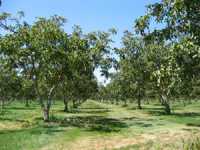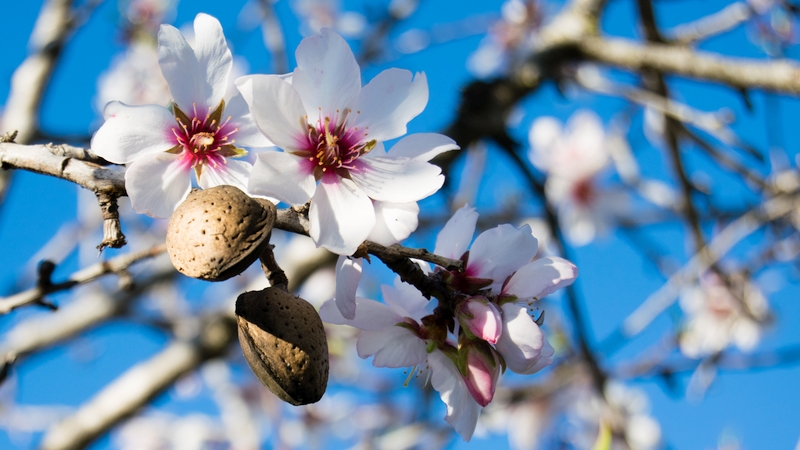Tips For Successful Walnut Replanting

Editor’s Note: The authors of this story, Carolyn DeBuse and Bill Krueger, are both University of California Cooperative Extension farm advisors emeritus, DeBuse in Solano and Yolo Counties, Krueger in Glenn County.
It happens often that a tree will die within a healthy orchard. The question is, do you replant or do you leave that tree spot empty? If you decide to replant, what is the best way to grow the young tree while still maintaining the surrounding orchard? This article will take a look at considerations when making replant decisions and some practices that will help the interplant survive.
• Sunlight Availability: When making the decision to replant or not, the most important question to ask is, “Is there enough sunlight to grow the replant to production size?” In many cases the interplants are planted into a shaded orchard and they struggle to reach full size, and many never do. If the tree can’t reach full size, then it may not be worth the expense in time and money to replant.
• Age Of Orchard: The age of the orchard is the first consideration when deciding whether to replant. If it is a young orchard and sunlight at the tree location is available throughout the day, replanting is a very good option. If the orchard is older and the tree canopy is at 75% to 95% coverage, the likelihood of the replant growing well is slim. The yield loss may be somewhat regained when the surrounding trees increase their fruiting area because of the increased light caused by the open space left by the missing tree. If this is the case, it may not be worth the trouble to replant.
• Orchard Planting Space: In wide-spaced or standard spaced orchards there may be more sunlight for the replant. Trees in hedgerow orchards are so close together that the surrounding trees will quickly fill in the space left by the missing tree. It is not often recommended to replant within a hedgerow.
Why Did It Die?
It is important to understand why the tree died because it relates to the success of the replant and steps you should take when replanting. As the tree’s health declines, try to evaluate the reasons it is sick by looking for symptoms of disease or pests. Take tissue samples to a plant pathology lab or request help from your pest control adviser or Cooperative Extension farm adviser to identify the cause. It may be that the orchard practices can be improved or preventative measures can be taken to moderate the chance of other trees becoming sick.
• Soil Pathogens: Often a tree will succumb to root and crown disease while the rest of the orchard seems unaffected. In the case of Phytophthora or oak root fungus, the fungus will remain in the soil and the interplant may become infected soon after planting. Opening the planting hole and letting the soil dry throughout the summer may reduce the fungi’s efficacy. Future irrigation should be applied carefully to avoid water logging the soil, which encourages the fungi while reducing tree growth. Nematodes can also be a reason for slow tree decline and a soil sample, with roots included, should be sent to a lab to test for them. Any soilborne pathogen may be reason enough to decide not to replant if surrounding older trees are still yielding well.
• Saturated Soil: If the tree succumbs to overly wet soil conditions either with over irrigating, heavy spring rains, or high water table, consider not replanting until the problem has been resolved.
• General Decline: General decline often happens in older orchards when there are many pests or diseases that can be found on a single dying tree. The tree may have dieback caused by sunburn, lack of vigor, branch wilt, Botryosphaeria, or Phomopsis. Trunk cankers from shallow or deep bark canker are often found in declining orchards. Crown gall can by itself reduce the health of the tree and shorten its life. If the orchard has many trees in some state of general decline, it may be better to farm the orchard until it is no longer economical, after which the whole orchard should be removed and replanted. It would not be recommended to replant individual missing trees in an orchard that is in general decline.
• Time and Inputs Considerations: Your time and money are worth something, so consider the effort and time needed to grow an interplanted tree. Each tree will need to be hand fertilized, staked and tied, pruned, and the irrigation modified. The cost of the tree and labor may be greater than the loss of the yield in your orchard. If the replanted trees are not well taken care of or they do not receive enough sunlight, then it is doubtful that they will ever yield enough for the return on your investment.
For more tips on replanting, go to the next page.
Replanting Tips
After careful consideration, you have decided to replant missing trees. The best way to have success is to follow the good planting practices that are well-known for planting a new orchard. Here are some highlights.
• Root Removal: When removing the dead tree, excavate a large area and try to remove all the roots. The excavation area should be about 8 to 10 foot square. Using a backhoe will help loosen compaction, dry out and mix the soil, prepare for spot fumigation, and reduce compaction.
• Fumigation: Spot fumigation increases the chance of replant success by a wide margin. There are individual tree site label rates for chloropicrin, Telone C-35, and methyl bromide. Drying out the soil and getting a good seal is important for fumigation success. Check with your county ag commissioner for current restrictions and regulations before applying any fumigant.
• Rootstock: In a replant situation you want a vigorous tree, and if possible you want a rootstock that can handle the soil pests and diseases that may be there already. Paradox seedling is more vigorous than California Black and is typically a better choice in a replant situation. Clonal Paradox Vlach and VX211 are also very vigorous. VX211 has shown tolerance to nematodes and Vlach moderate resistance to crown gall. In orchards where Phytophthora is present, clonal Paradox RX1 may be a good choice. Clonal rootstocks are commercially available.
• Plant Correctly: Good planting practices need to be followed when planting interplants. It is important to rebuild the berm and make sure the tree is planted high. It is a common mistake to replant the tree too low with a sunken area around it, creating a wet situation around the crown of the tree and lowering the tree’s chance of survival.
• Irrigation: Irrigation is very difficult for replants. The young tree needs less water than the older trees in the orchard, but the water has to be accurately placed into their root zone. Relying on the mature orchard’s irrigation system can leave the little trees too wet or too dry. The best set-up is a modified drip or microsprinkler for each tree with care to adjust it throughout the season as needed. If there are a number of replants in the orchard it may also be possible to shorten the intervals between irrigations and reduce the time or amount of application without significantly changing the total application to better meet the needs of the replant while adequately irrigating the mature trees. This would only be necessary until the replants become established.
• Fertilization: This is one of the most important points to remember when interplanting in a mature orchard. The young tree is being planted in the same location that the removed tree mined for nutrients in the previous years. For success it will need to be fertilized much more regularly with small amounts each time. In many cases a full fertilizer with nitrogen, phosphorous, potassium, and zinc has shown positive results in the first year of growth. Hand application is the easiest way to manage this.
• Light Management: If the decision is made to replant but shading is a concern, it may be necessary to prune back the surrounding trees just enough to allow for good light penetration for the developing replant.










